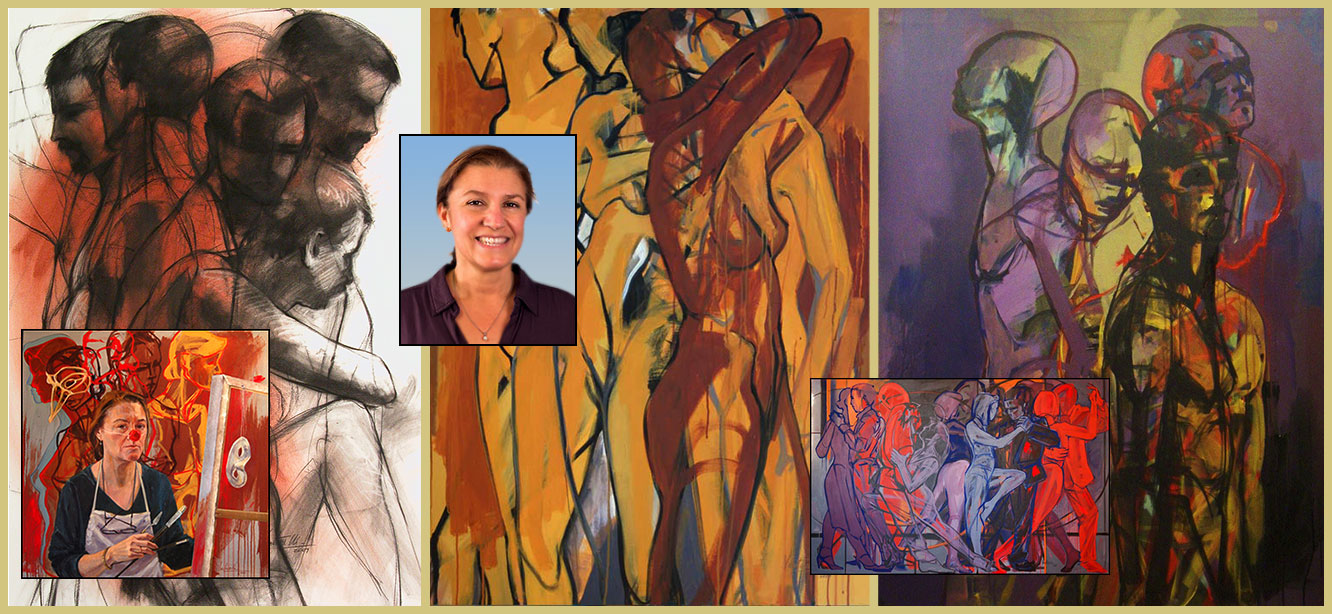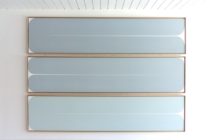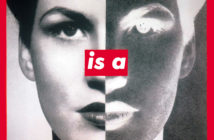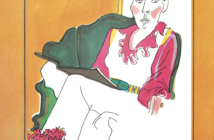Dear Artist,
Most of us paint first and title last. Sometimes, about the middle, a title just pops out of the ether. And a few of us get a title in our heads and figure out the work to go with it. Particularly with whimsical and didactic art, this last system is worth considering. The right title makes a difference as to how a work is seen and understood. Not only are titles a bridge to the viewer, they are also part of the art. I’m a believer in giving your titles some careful thought.

“Self-portrait, The Desperate Man”
oil painting ca. 1843–45
Gustave Courbet (1819-1877)
Private collection
There are five main kinds of titles: Sentimental, Numerical, Factual, Abstract and Mysterious. For comparison purposes, take a recent painting of weathered totems near a snowy, deserted village. The somewhat sentimental title I chose, The Long Winter, attempts to comment generally on the current state of our native peoples. Following my five main kinds mentioned above, other titles worth considering for this work might be Habitations 17, Late Light–the Village of Skidegate under Snow, Pattern, December, and Billy Martin’s Haida Wife. (She’s not in the picture.)

“The Painter’s Studio: A Real Allegory of a Seven Year Phase in my Artistic and Moral Life”
oil on canvas 359 x 598 cm
by Gustave Courbet, 1855
Artists do well to set up their works and run them by a series of title possibilities. Ask yourself, “What am I truly saying here and what might be the sub-text of this?” Consider the implications of your proposed titles and how they might add or subtract from your purposes. Like cut-lines to newspaper illustrations, titles serve to confirm what’s seen but also to add knowledge, insight and a glimpse into the author’s mind-set. On the other hand, art titling is often used to obfuscate or evoke irony. J.M.W. Turner is an example of an artist who used ironic, compound titles — e.g., The Fighting ‘Temeraire,’ tugged to her last berth to be broken up, 1838.
Abstract art can present titling challenges. The formal values of the work itself may be mentioned — e.g., Red on Blue. Titling can also give viewers a clue that might help them on a voyage of imagination and discovery — e.g., Talisman. Sometimes, in this direction, you don’t want to say too much. Brevity is enigmatic.

“The Fighting ‘Temeraire, tugged to her last berth to be broken up, 1838”
1839 oil on canvas, 36 × 48 inches
by J.M.W. Turner (1775-1851)
Best regards,
Robert
PS: “Titles do not give a just idea of things; were it otherwise, the work would be superfluous.” (Gustave Courbet) “I’ll play it first and tell you what it is later.” (Miles Davis) “Only connect.” (E. M. Forster)
Esoterica: “What, where, when, why and how,” are basic questions journalists try to answer. In titling art, it’s different — not all questions need be answered. Having said that, a tried and true system is to give your work a sense of place and possibly time: Peggy’s Cove, Jan — what viewers are looking at and satisfies the basic human need for labelling. If you’re interested in telling more about your own personality or methodology, consider adding a “floater.” For example, Peggy’s Cove with Stravinsky.
This letter was originally published as “Titles of paintings” on May 2, 2006.
Below is a selection of alternate titles for my dad’s painting, “The Long Winter,” contributed by our readers when this letter was originally published. If you look at the painting and read some of these titles you’ll notice how some of them monumentalize and even anthropomorphize the subject further. Others seem to trivialize the work; yet others enhance and invite the viewer to think and dream — still others add yet another dimension. Very few give further information such as Chief Williams’ Wolf Poles at Kitsegukla (this is understandable for obvious reasons.) Ask yourself if it is valuable to repeat what the painting already tries to say to the viewer, and also in what cases should humour or cute stuff be used. We invite you to add to this list, and tell us about your own titling techniques in the comments below. –Sara Genn
Standing in the Winds of Change — Jill Paris Rody
Triumvirate — Dave Wilson
Old Wind
Old Breeze
Old Wind From the North — Jim Larson
Haida Dance Over the Snows — Patricia Peterson
Legends Lost — Diann Haist
North Wind, Old Friend — Jim Larson
Tales of the Past
Lest We Forget
Frozen in Time
Wintry Sentinels
Frozen Tales — Lesley White
Three watcher’s west — Georges Lamarck
The Gatekeepers — Arnold Bloch
Snow-Covered Skidegate — Mary Wiley
Silent Vigil — Bonnie Hearn
The Gods at Rest — Len Sodenkamp
Silent Watch — Suzette Fram
Silent Watchers — Jack Newton
Sentinels of the Soul — Warren Beals
Soul Sentinels
Eternal Paternal — John Fitzsimmons
Ray of Hope — Tony Melcher
Dawn, Heckate Straits — B. L. Noble
Time Passing
History/Eternity
The Ancient and The Timeless
Cold Memories, Warm Dreams — Eleanor Blair
All Flights Cancelled — William Puryear
Dawn but not Forgotten — Jennifer Weber
Totem Jury — Carol James
The still souls — Rose Ritson
Left out in the cold — Betty Newcomer
Homage to Teotihuacán, the Sun God
Space, the Final Frontier — Luz Maria Perez
Damn, where’s my Jacket? — Beaman Cole
Evening Sentinels — Kay Hansen
Looking Beyond the Present — Jeanine Fondacaro
Good Night Fair Friends
Another Day Gone — Linda B
Skidegate Winter — Inga Nykwist
Stories in Snow
Cedar Stories
Tales in Carved Cedar
Skidegate Stories in Snow — Liz Runacres
Tales the Totems Tell — Arnold Pitzer
Golden Stillness — Billie Carr
Totems in the Cold — Sue Boies
The Spirits Awaken from Winter — Alice Berkshire
[fbcomments url=”http://clicks.robertgenn.com/titles-of-paintings.php”]
Featured Workshop: Nora Venturelli

Midnight in the Walled City acrylic and collage on canvas, 24 x 30 x 1.5 inches |







11 Comments
Why would I ever wish to unsubscribe? Robert and Sara are part of my art family. If all else fails I amuse myself by reading the first sentence of the letter and guessing which one wrote it. I get four out of five! Long live The Painters Keys!!!
Yes, I agree! I have been inspired by the Genn’s to write my own Art Blog but their thoughts are still a source of wonder!
“Centennial Sentries” or “On Watch” are a couple of titles that bounced into my head for Robert’s painting. I like a play on words or an alliteration… and some humour.
This letter pretty much sums it up for naming an artwork. I have named everything since I started in 1965 – the words typically come to me when I am about halfway through the process. Life is good!
This idea of five main kinds of titles interests me and I’ll sure come back to this enlightenment next time I have a dilemma! I have certainly found that, for some paintings, a title comes to me instantly. There are others that I’ve agonized about and never settled on anything I liked. I wrote a short blog post about this here: http://lynndavis-smith.com/?p=783
I can identify. Sometimes the titles come easily and other ???
To respond to the posted article: I think images speak to each viewer according to their own lifetime experiences. Titles could be limiting should the viewer ever stoop to read them. The images should carry the weight and propel the viewer across the gallery floor to view the image up close. Titles are insidental to the viewing experience.
“Waiting in Silence, Skidegate Winter” But I do like Robert’s title, The Long Winter, best. It evokes a sense of story, and carries many layers of images with it.
‘Waiting’ or ‘Loneliness’, I feel such sorrow and hope in this painting. Can’t wait until Spring!! Thank you Sara for reprinting, AND continuing Robert’s legacy with your own posts.
I believe a good title adds something special to the painting. That is why I keep post-it notes available. When a good title comes to me I quickly jot it down and stick it on my computer monitor. If I am out with friends and through conversation a title comes to me I quickly grab my pocket-sized sketchbook and scribble it down. Next comes the fun assignment of doing a painting that lives up to these great titles.
I love this article. Titles are paramount in my art work. Thank you for sharing.
In and of itself…titles are pretty wierd. In a sense , you need them to stamp the work. On the other hand, it can become a “thing” in itself and distract from the big enchilada…the painting. I have done hundreds of paintings by now and I don’t believe the titles mean that much. But on some of my paintings they are very important The title and the painting can instead become “partners “in enhancing the work. A title can inform something about the meaning in a way that the painting can not. Nowadays and as almost always, a title name won’t come to me until the painting is almost done. Then I tell myself, ” At least it’s better than a number ” and I leave it at that. But I did think a while about the totem painting above and I could feel the wind pushing against the slanted totems. The landscape in Mr Glenns’ painting has great depth of field and you can’t escape that sense of time and what it might mean. While the artist seems to be asking the viewer to study the faces on the poles; the longerI lookedI had to wonder just what are they looking out at? I think it was the wind…invisible but real. Transparant and sometimes deadly…perhaps infallable. If I was the wind, a spirit looking back in communication with those people who had such stamina and effort to pearched those totems so high above the valleys, perhaps seeking a kind of communion with me, the carver of hill tops. I would have been charmed and blow them a perpetual kiss until the poles slanted backwards to let them know my apprecciation.. So here is my title.
Sons of Windy River